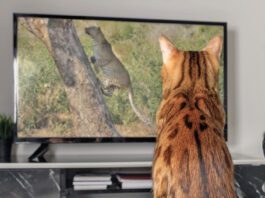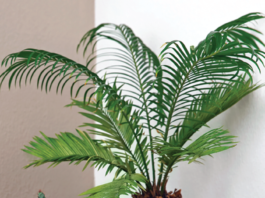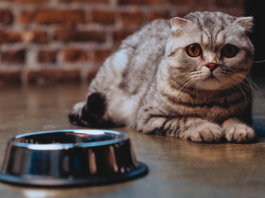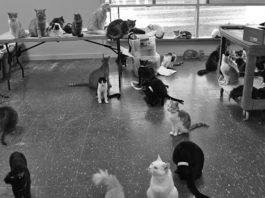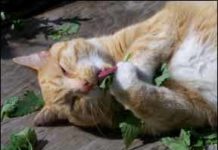Ask Elizabeth: November 2011
Dear Elizabeth: Our seven-year-old female cat Queenie is a spayed, well-behaved Siamese who is never allowed outside. However, there are several free-roaming outdoor cats in the neighborhood, and they have become a real nuisance. About six months ago, my husband and I started smelling evidence that the front of our house and our doors were being scent-marked. The odor of urine is quite noticeable and unpleasant for us and also seems to agitate Queenie. We’ve thought about putting some sort of repellent outside, but we don’t want to use anything that could harm these neighborhood cats or wildlife. Do you have any recommendations? What can we do to stop — or at least discourage — these cats from scent-marking our house?
Short Takes: October 2011
Cytauxzoonosis — often a fatal infection in domestic cats — is a disease caused by the parasite Cytauxzoon felis, which is transmitted by the bite of a tick. Most affected cats are young adults with exposure to the outdoors and vague clinical signs of lethargy and anorexia. Treatment for cytauxzoonosis is usually imidocarb diproprionate, but a combination of atovaquone and azithromycin (A&A) has also been utilized as a treatment. (neither form of therapy has been prospectively evaluated for efficacy, however). Eighty acutely ill cats with Cytauxzoon felis infection were treated at various veterinary clinics. Of 53 cats treated with A&A, 32 (60 percent) survived to discharge.
Maladies of the Feline Ear
While most cats will go through life without experiencing a serious problem with their ears, owners should know that a variety of conditions — including congenital defects, infections, trauma, and age-related changes — can be extremely painful and may compromise an animal’s hearing. Most feline ear disorders are readily treatable and will not result in permanent hearing loss, notes James Flanders, DVM, an associate professor of surgery at Cornell University’s College of Veterinary Medicine. However, some conditions may render a cat partially or totally deaf, especially if they remain unrecognized and untreated.
Short Takes: September 2011
Onion, garlic, leek, chives, shallots and scallions are all part of the genus, Allium. Unfortunately, all Allium species can be poisonous to dogs and cats; their toxic components can damage red blood cells (RBC), leading to a hemolytic anemia. Cats in particular are two to three times more susceptible to RBC damage from these components than other species. Onion toxicosis is noted in animals that consume more than 0.5 percent of their body weight (for instance, for a 10 lb cat, this would be 8 ounces).
Welcome to the Feline Historical Museum in OH
The birth of the Feline Historical Museum was celebrated during the opening ceremonies of the Cat Fanciers’ Association. The museum is billed as the world’s largest devoted to felines, featuring a cat library, feline-related artwork and historical items. The foundation has an abundance of additional artifacts and pieces of art in storage, and the items will be rotated periodically.
Videos To Entertain the Indoor Cat
A bored cat is likely an unhappy cat. Just like humans, cats need stimulation; and when left on their own too long, they can experience loneliness and even depression. An unhappy cat may lose or gain weight, stop grooming itself, or become destructive. And a cat with nothing to do will often sleep the day away instead of getting needed exercise. For those of us who must leave our pets alone for long hours while at work or elsewhere, the solution is only a click away: Turn on the TV and put on a cat movie.
Ask Elizabeth: July 2011
Dear Elizabeth: I have four cats in my household and one of them, Tabitha, has a tendency to chew and eat plastic. Ive caught her chewing on plastic bags that Ive carried in from the store, as well as items in the basement that are wrapped in plastic. I worry that she could choke to death or hurt herself somehow. Why does she do this? One of my other cats is aggressive and chases her. Tabitha is afraid and will not fight back; could her plastic obsession be stress-related? Any ideas of what I can do?
Moving With Your Pets Safely
Moving day can be a miserable, hectic blur - one of those times youd really like to be able to just twitch your nose and be done with it. Unfortunately, it just isnt that easy. And cat owners have the added stress of worrying about how their cat(s) will react to the disorder and mayhem. However, there are several precautions that can be taken to help ensure that your pet will remain safe during the move - and to promote a quick adjustment to his new home.
How to Find the Right Pet Sitter
You have a wonderful vacation planned: a two-week escapade to the Caribbean after a long year of hard work and stress. Youve been looking forward to it for months, but a nagging problem remains: Who is the best person to take care of Whiskers while youre away? This important decision should depend on your cats personality, health condition, age and the resources available where you live. Hiring a pet sitter, kenneling your cat or even boarding him with a veterinarian are options for care when you arent home.
Is It Urine Marking or Incontinence?
When a cat begins soiling the house, it is usually assumed that it is a behavioral problem or the onset of senility. However, there are several medical conditions that can cause urinary incontinence and inappropriate urination, some of which require immediate treatment. First, it is important to distinguish between incontinence and inappropriate urination. True incontinence occurs when a cat does not have voluntary control over urination; trauma, a weak primary sphincter muscle and congenital abnormalities are the most common causes of incontinence.
Providing Good Cat Care on a Budget
With the economy struggling, its comforting to know that are plenty of ways to defray the cost of owning a cat without compromising your pets well-being. In fact, some of the most effective strategies can actually benefit your cat. According to Jodi Korich, DVM, former director of Partners in Animal Health at Cornell Universitys College of Veterinary Medicine, "One of the best ways to save money on your pets health is to pay attention to early disease detection and preventive health care." Just like oil changes and preventive maintenance result in fewer repair bills for your car, she says, regular check-ups and early intervention will save you money in the long-run.
The Effects of Catnip
Planters of catnip, beware! This perennial is a member of the mint family - like spearmint and oregano - and it reproduces by spreading runners beneath the soil. Put one catnip plant in your garden and in five years it may well have taken over. Veteran gardeners plant catnip in buried containers, or in above-ground pots that even the hardiest and most aggressive roots cant escape. Despite the voracious nature of the plant, however, its worth having around. Carolyn McDaniel, VMD, a consultant at the Feline Health Center at Cornell Universitys College of Veterinary Medicine, says, "Catnip is non-toxic, non-addicting and low calorie. It can definitely play a valuable part of an indoor cats environmental enrichment."


